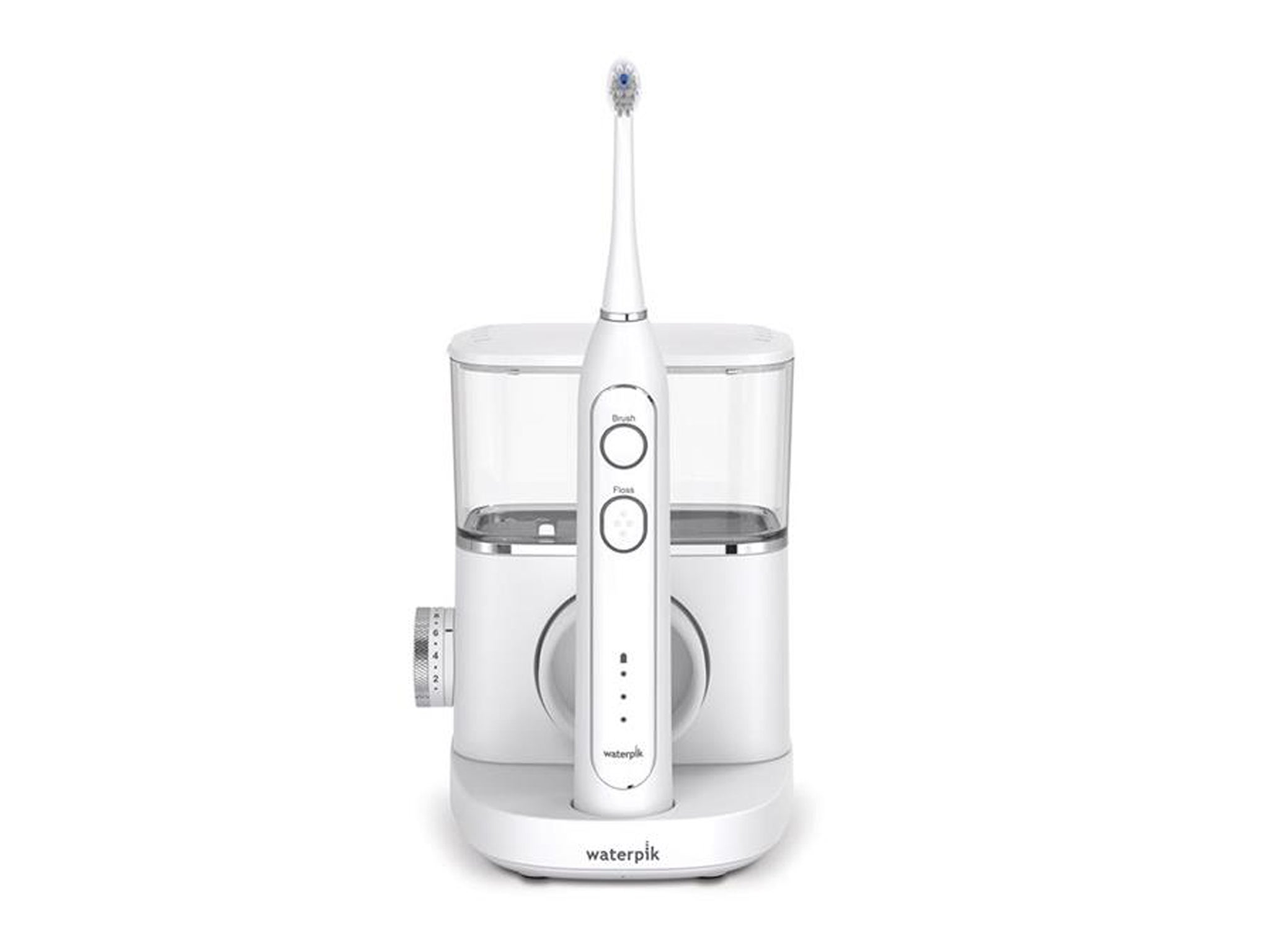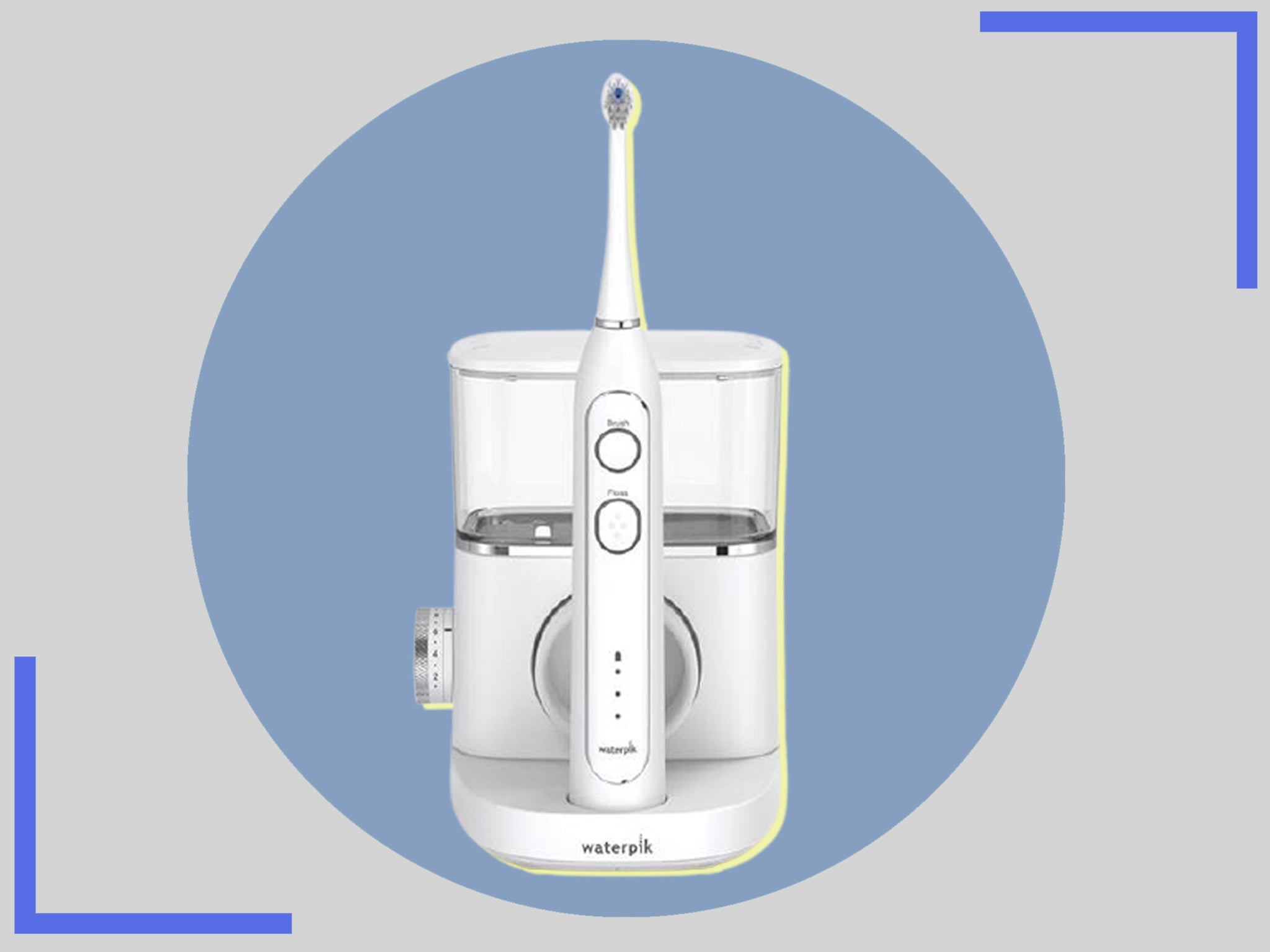Waterpik Sonic-Fusion toothbrush

- Cleaning technology? Sonic
- Flosser pressure settings? 10
- 30-second pacer? Yes
- 2-minute timer? Yes
- Pressure sensor? No
- Travel case? Yes
- Waterproof? Yes
- Brushing modes? 1
- Weight? 800g
- Charging time? 4 hours
- Usage? 14 brushing sessions
- Rating: 7/10
The toothbrush
Unlike the flosser, which needs to be attached (via a small hose) to the base unit to work, the brush has a built-in Nickel Metal Hydride (NiMH) battery so it detaches from the hose and can be used on its own. If you’re used to using Sonicare or Oral-B brushes, you’ll notice some differences in the ergonomics as it does feel significantly heavier and has a thicker handle, which might have something to do with the NiMH battery, unlike the other brushes, which use lithium-ion.
On the back there are raised dots to help grip when it’s wet and there are three modes to choose from: brush, floss, or brush and floss. This means there is really only one brush mode, so if you don’t get on with that then you don’t have any options to cycle to another one. Similarly, there’s only one brush head so if the bristle pattern doesn’t suit your needs (for example, if you need an orthodontic head) then this probably isn’t the right brush for you.
The brush head is ever so slightly angled to give easier access to hard to reach areas of the mouth and it’s about the same size as an Oral-B head with bristles that were nice and natural feeling while also being robust enough to feel like our teeth were getting clean. There are no in-built warnings that the brush is getting worn down with use, so you have to set a reminder yourself that the brush head should be changed after the manufacturer recommended, three months.
Read more: The Oral-B teen is the perfect entry-level electric toothbrush
Our experience of using the Waterpik toothbrush felt very different to its closest rival, which would be a Sonicare product, as they both use the same cleaning technology with the Waterpik offering the user 30,000 brush strokes per minute, which is slightly less than Sonicare brushes. We found that the deep clean feeling was lacking from the Waterpik although it still offered thorough coverage and the brush head made it easy to access every surface of the tooth, however we finished our two minutes without the usual confidence that our teeth had been entirely swept of food and plaque.
However, let’s not forget that the Waterpik is designed to be used in combination with the flosser and so we hoped for better results when we hit the large floss button at our next brushing session.
The flosser
If you’re not used to flossing machines one of the first things you’ll notice is that the Waterpik’s footprint is significantly bigger than an electric brushes, as it has to accommodate the pump and water reservoir, so you’ll need to think about where you’re going to position it so that it’s stable.
Unlike when you use the brush in isolation the flosser has to be attached to the base unit so it has a reservoir of water to draw from, with the jet pressure controlled via a rotating disc, which is also on the base unit. The jet can be adjusted during brushing, according to your comfort, which is a real positive as we’ve used some water flossers that need to be turned off before you can make any tweaks to the pressure.
Read more: We put the Foreo issa mikro toothbrush to the test
One press of the large floss button and the water will begin at your preferred pressure, but you’ll need to lean over the sink as the flosser goes to work, as there is a continual jet of water being sent into, around and out of your mouth. There is also a greater chance that the handle of the brush will get wet when using the flosser and we would have liked to see some extra grip, over and above the dot rows.
The Waterpik demonstration video shows a woman using the flosser very gracefully, but in our experience it was a very messy business and we definitely needed to be over the sink for the duration.
This presented us with a problem because the hose is only around 80cm long, so the base unit needs to be located close to your sink. However, the base also needs to be powered up and plugged into your bathroom’s shaver point, so you need a base for the unit and a power point all within close proximity to your sink – if you don’t, you could struggle to use the flosser.
Read more: 9 best kids’ electric and manual toothbrushes
The power of the jet, even at level 7, was such that it really did feel like we were getting a professional deep clean that was very satisfying. Used with the brush, as the manufacturer intended, offered a much more complete experience as it felt like the brush’s cleaning power was enhanced and that it was also loosening up food and plaque and priming it to be jet blasted away by the action of the flosser’s jet.
However, after using the two in combination we would suggest that you turn the flosser off and finish in the brush mode just to make sure that you’re laying down a foundation of fluoride on the teeth, which otherwise would be washed away by the water from the flosser.
